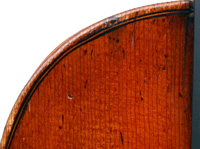Ref : 0627
A very good English violin by
Certified by W.E.Hill & Sons (1913)
Richard DUKE
(Active in London : 1750-1785)
London, circa 1765
Despite all the well-deserved accolades directed at Richard Duke, he remains a mystery character. Information about his birth and death remains speculative and all that we know for certain is that he was active in London from around 1750 to 1785, that he conducted a successful business there and that he exerted great influence on his contemporaries. Today he ranks among the important English violinmakers. Duke modelled his work on Stainer, Amati and at times on Stradivari. His work varies greatly from instrument to instrument and holding a Duke in the hand is always an interesting experience because of the wide divergence of his work - no two instruments are ever the same.This violin is unlabelled, but is stamped "Duke" in the back, just below the button. The scroll is later, and not Duke's work. The original paperwork for the violin was lost in a burglary some years ago, but fortunately a complete set of photocopies of the paperwork survived and comes with the violin. This includes copies of a certificate by W E Hill & Sons (dated 1 August 1913) which authenticates the violin and confirms that the scroll is not the original. According to an accompanying 1985 letter by David Hill, the violin should date from between 1760 and 1770. There are also receipts by the violinmaker Adam Mackie dating from 1928 and diverse notes by one of the recent owners.
The modelling is very flat and more Amatian - unusual for Duke and unlike many of his other instruments with their high Stainer-type arching. The one-piece back is of fairly plain maple with a mild flame. The sides though are more interestingly figured. The neck graft is fabulously done - the work of a superb craftsman. The scroll (by an unknown maker - possibly by the Hill studio) is truly beautiful from every perspective - a worthy match for a fine instrument.
This violin is slightly smaller than standard (354 mm). It is unusually well-toned and very satisfying to play on.
 |
 |
 |
||
 |
Dimensions : 35.4 cm
Condition Report : This violin is in excellent condition after some 240 years - it does not even have a wingcrack. Throughout it appears to be free from discernable cracks or repairs. Except for the scroll, all parts and varnish appear to be original.
Provenance : Sold by W.E.Hill & Sons to Miss N Dedman of Maldon, UK on 1 August 1913.Then acquired by the violinmaker, Adam Mackie in Johannesburg, who sold it in July 1928 to Mr James Brownlie of Johannesburg. Inherited in May 1988 by the latter's son, William Brownlie, who donated it to Mr J. Beukes. The violin was then acquired by an important professional violinist who used it as his principal instrument until his death.
Price : Withheld
 |
 |
 |
 |
 |
 |
 |
 |
 |
 |
|||||